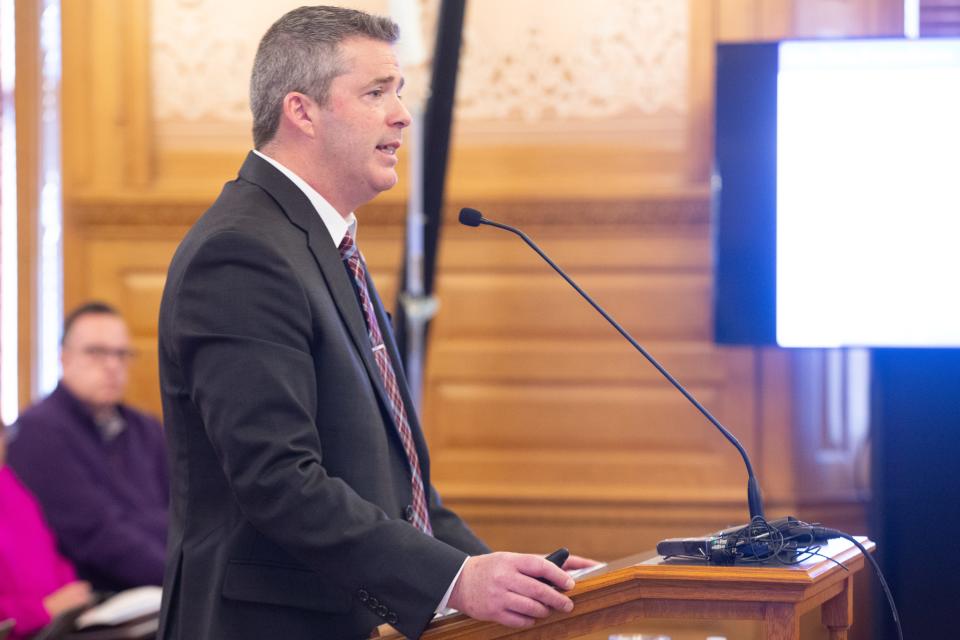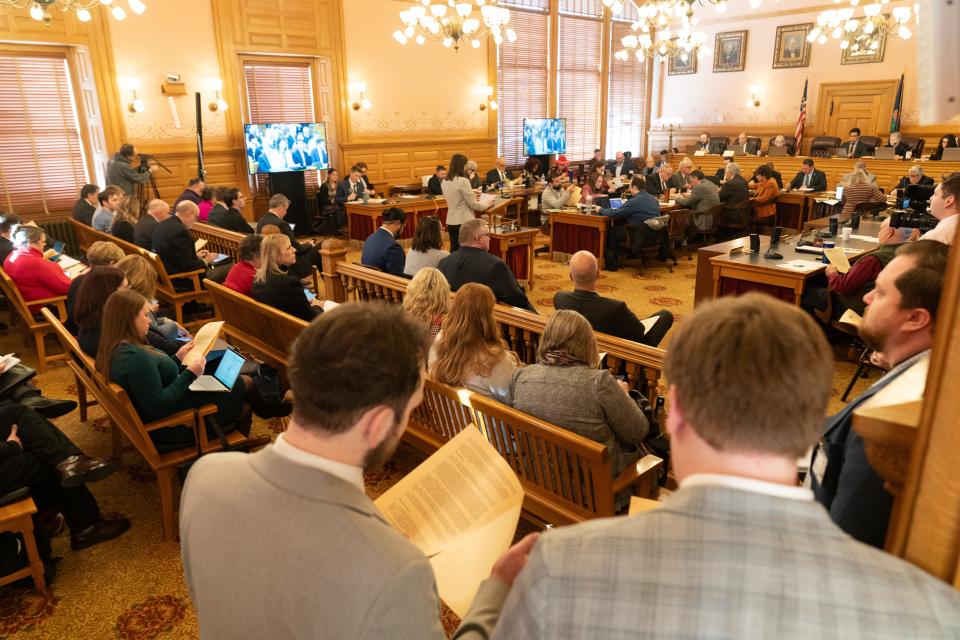A $15 minimum wage for state employees? Here's what to know about Kansas budget proposals
- Oops!Something went wrong.Please try again later.
Budget director Adam Proffitt presented Gov. Laura Kelly's budget proposal to the Kansas Legislature on Thursday.
Here are the highlights of the budget proposal.
Will there be state employee pay raises?
Employees of Kansas state government are in line for a pay raise under the governor's budget proposal.
It starts with implementing a $15 minimum wage for state workers. It wouldn't change the private sector minimum wage of $7.25 an hour.
"The governor is making the policy recommendation that for the state of Kansas as an employer, not rewriting the state's minimum wage standards for private sector, but state of Kansas, we want to start every employee at $15 an hour," Proffitt said.
"We feel like that's a good starting point for a livable wage in Kansas," he said.

The state government currently has 969 employees earning less than $15 an hour, including administrative assistants, food service employees and laundry workers. The cost is $3 million in all funds, but $2 million from the state general fund.
"We'll look into it," said Rep. Troy Waymaster, R-Bunker Hill and chair of the House's budget committee, who acknowledged that the state has a history of "not paying employees very well."
From there, the vast majority of state workers would get a 5% raise. That means people who got the raise to $15 an hour would also get the 5% raise.
The cost is $169 million in all funds, with $69 million of that from the state general fund.
On top of the 5% raise, employees of 24/7 facilities like prisons and nursing facilities would get an additional adjustment.
Proffitt said the differential pay plan for those facilities was intended to be temporary to stabilize the workforce but should become permanent. The adjustments to those differentials, converting some into base pay, would have minimal budget impact because the spending is already accounted for in agency allocations.
But salaried employees, who in some cases have starting supervisor pay below the highest-paid hourly employees at the same facilities, would see a 7.5% raise. The required $2.6 million, all from the state general fund, would address a situation that has stunted natural career progression.
"We've targeted a lot of the funds on the hourly staff there, and rightfully so," Proffitt said. "They've done just incredible work there and it's been a successful program. Now we need to recognize the efforts of the salaried individuals."
Topeka, Hutchinson and Salina in line for capital projects
The governor proposed using the surplus from the state general fund for one-time payments on projects to avoid building debt.
Kansas accumulated nearly $1 billion from pandemic-era federal aid. Kelly recommends using the money to pay off debt early, pay for new construction of facility improvements, invest in community projects and putting money toward collegiate education projects.
Over $40 million is slated for the Topeka Correctional Facility’s reconstruction of a medical and behavioral support building. The building lacks an isolation room for people with infectious diseases, only has one suicide watch bed and the shared office space is insufficient, Proffitt said.
“The current medical building was built when the capacity, the number of beds in the facility, was 450. At current, that facility has nearly 900 beds. So the number of beds has doubled, but this facility to treat medical and behavioral health issues remains the same,” Proffitt said.
The largest proposed expense is $377 million to reconstruct the Hutchinson Correctional Facility, which at 150 years old is about twice as old as a typical prison is when it is decommissioned. Proffitt said the facility is in a state of disrepair: that one side of the structure is concrete with no air conditioning, the cells are about the size of a half bathroom. It isn't ADA compliant and the east unit is built with materials that are now considered a fire hazard.
The conditions are dangerous for both inmates and the hundreds of corrections officers employed there.
Proffitt said the number of upgrades to the existing building would exceed the cost of creating a new facility. The one-time payment would also avoid debt.
“If we were to issue a bond, a 20-year bond at a about a 3.75% interest rate, that would cost us about $140 to $150 million in interest. So we can avoid that interest cost by paying cash right now to construct that facility,” Proffitt said.
Kelly’s proposal will also dip into the State Highway Fund to upgrade the Kansas Highway Patrol Training Academy in Salina. Proffitt said the academy, which is housed in an old college, has many of the amenities the highway patrol needs, but would benefit from $7 million to upgrade its infrastructure.
Another $10 million is requested to create a new emergency communication center, which is currently housed at the KHPTA campus. Proffitt said the current building is susceptible to storms and going offline. The proposed new building would be moved off-campus to land currently owned by the Kansas Department of Transportation.

Capital projects, like those above and several others, are part of a strategy to spend money on one-time expenses. The increase in base spending is 2.2%, Proffitt said, which is less than inflation.
That focus on one-time expenses means paying cash instead of issuing debt on some capital projects.
"Historically with capital projects in the state of Kansas, we've been in the position where we had to issue bonds in order to cover the costs up front," Proffitt said. "And obviously when you issue a bond, you're carrying debt as an interest costs."
It also means paying off debt early. There's $450 million on pension obligation bonds, $48 million in other bond early payment and $11 million in capital lease prepayment.
School funding, including more money for special education
Education funding comes with money for early childhood education as there are multiple funding streams to expand child care availability in Kansas.
There is $56 million to fund coordinated efforts, $30 million for capacity accelerator grants, $15 million for sustainability grants and $5 million for a pilot program.
Kelly's budget calls for fully funding K-12 public schools while adding money for professional development, mentor teachers and expanding the mental health intervention team pilot program.
She also renewed her proposed five-year phase-in of more special education funding. Kelly would add $75 million each of the next five years to get to the funding level established in state law.
More: Special education task force finally meets. Will Kansas schools get more money?
Can Kansas universities increase tuition next year?
Despite a campaign promise in 2022 that she would "continue supporting tuition freezes," for the second year in a row, Kelly won't freeze tuition at state universities.
"The governor is not putting a provision in the budget to freeze tuition," Proffitt said. "Instead, we're funding measures that should address student affordability and some of the capital projects that the universities have been longing for."
Some of those other investments include $14 million in additional need-based scholarship aid funding, $13 million for Emporia State University to pay off debt on student housing in exchange for not increasing costs for students and $5 million for a student affordability program at Wichita State University.
Does the budget match the rhetoric of supporting rural Kansas?
"My overall impression of it," said Waymaster, chair of the House's budget committee, of Kelly's budget, "is it's not bad. Obviously, there's going to be some modifications that we're going to make, some changes, but I have to say it's not a particularly bad budget."
He did take issue with how it compares to Kelly's State of the State address on Wednesday, where the governor emphasized a commitment to rural Kansas.
"We heard extensively last night how important rural Kansas is," Waymaster said, but he doesn't think the governor's budget reflects that rhetoric.
Proffitt disagreed.
"This budget is absolutely targeted towards all Kansas," Proffitt said, "and there are many provisions that are going to help rural Kansas specifically."
He pointed to water investments, including fully funding the state water plan, using $10 million to assist small towns with water infrastructure and establishing a water institute at Kansas State University with $5 million.
"Water is a statewide issue, but largely is needed and is depleting out in western Kansas," Proffitt said.
He noted $15 million for expansion of a nursing workforce development program at Fort Hays State University, as well as $5 million in child care funding specific to northwest Kansas.
And while there was some criticism, including from Waymaster, of World Cup funding benefiting northeastern urban and suburban areas, Proffitt said "we're actually looking at a 200-mile radius for who that's going to impact, so that certainly gets into parts of rural Kansas."
He also argued that Medicaid expansion will benefit rural hospitals — and that it would be budget-neutral for 15 years.
"It is not a silver bullet for rural hospitals, but it's a great, great injection for hospitals. and that's also a benefit for those rural residents," he said.
Kansas currently has a large budget surplus
Kansas has a large projected budget surplus, assuming no major spending increases or decreases, no new tax cuts or increases and no significant change in economic growth or recession.
The Kansas Legislative Research Department reported a $2.4 billion ending balance plus $1.6 billion in a rainy day fund in fiscal year 2023.
For the current fiscal year 2024, which ends June 30, the projection is $2.8 billion in ending balance and $1.7 billion in the rainy day fund. For fiscal year 2025, which starts July 1, the projected ending balance is $3.5 billion with $1.8 billion in the rainy day fund.
"I never would have guessed we would be anything close to this," said J.G. Scott, the KLRD director.
Under the governor's proposed budget and tax cut plan, the fiscal year 2025 ending balance would drop to $1.4 billion with $1.8 billion in the rainy day fund.
Jason Alatidd is a Statehouse reporter for the Topeka Capital-Journal. He can be reached by email at jalatidd@gannett.com. Follow him on X @Jason_Alatidd.
This article originally appeared on Topeka Capital-Journal: Kansas governor's budget proposal includes pay raise for state workers

